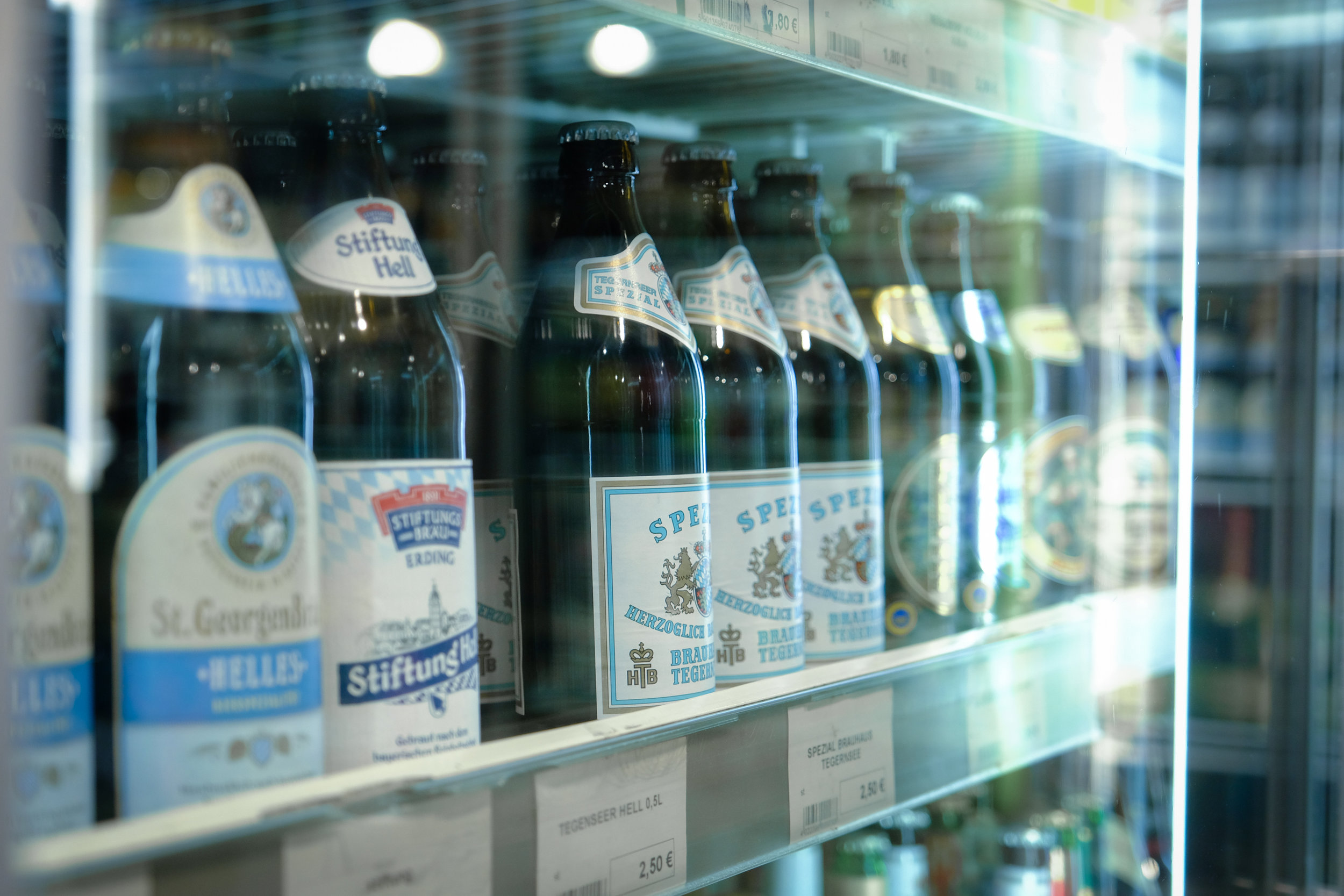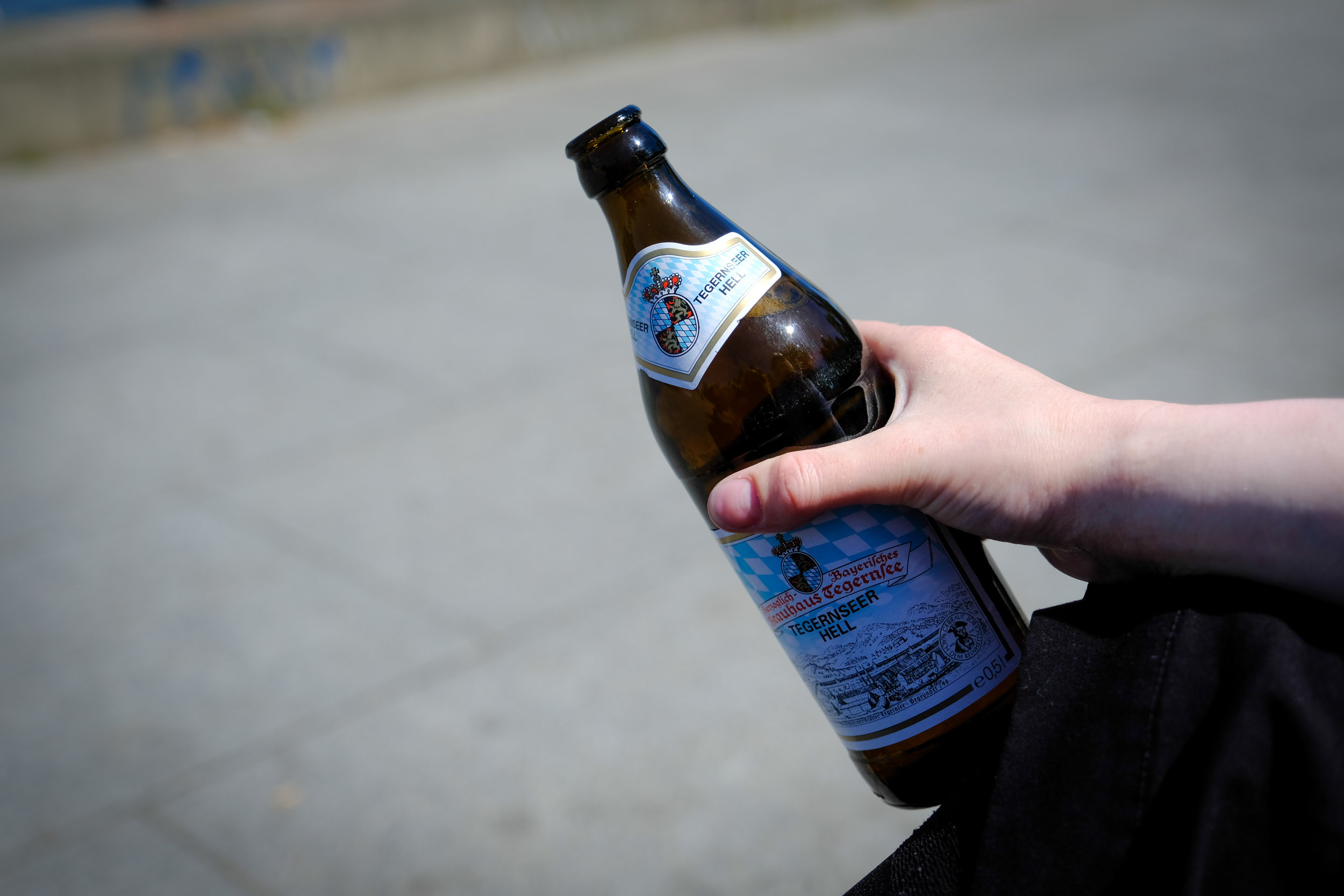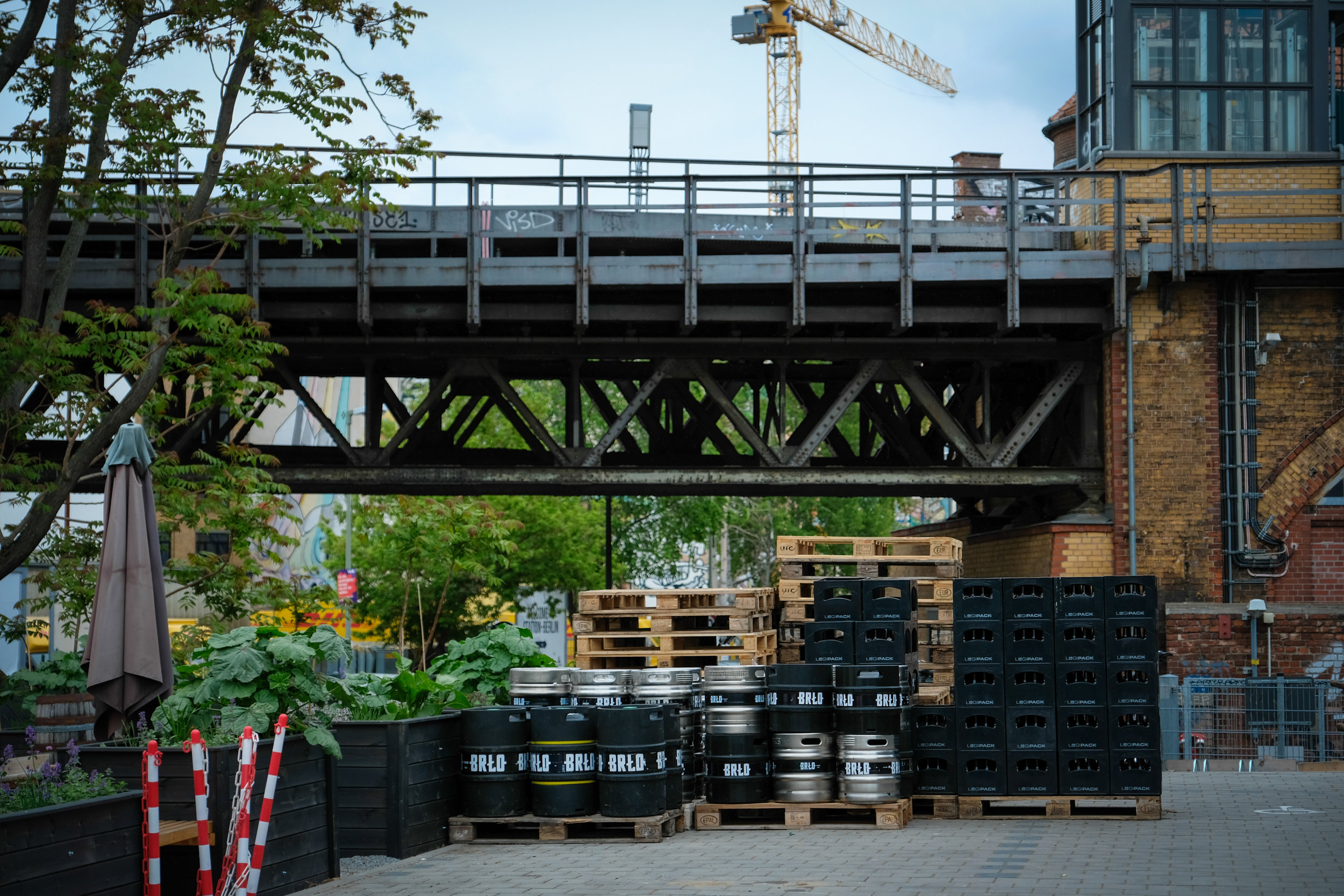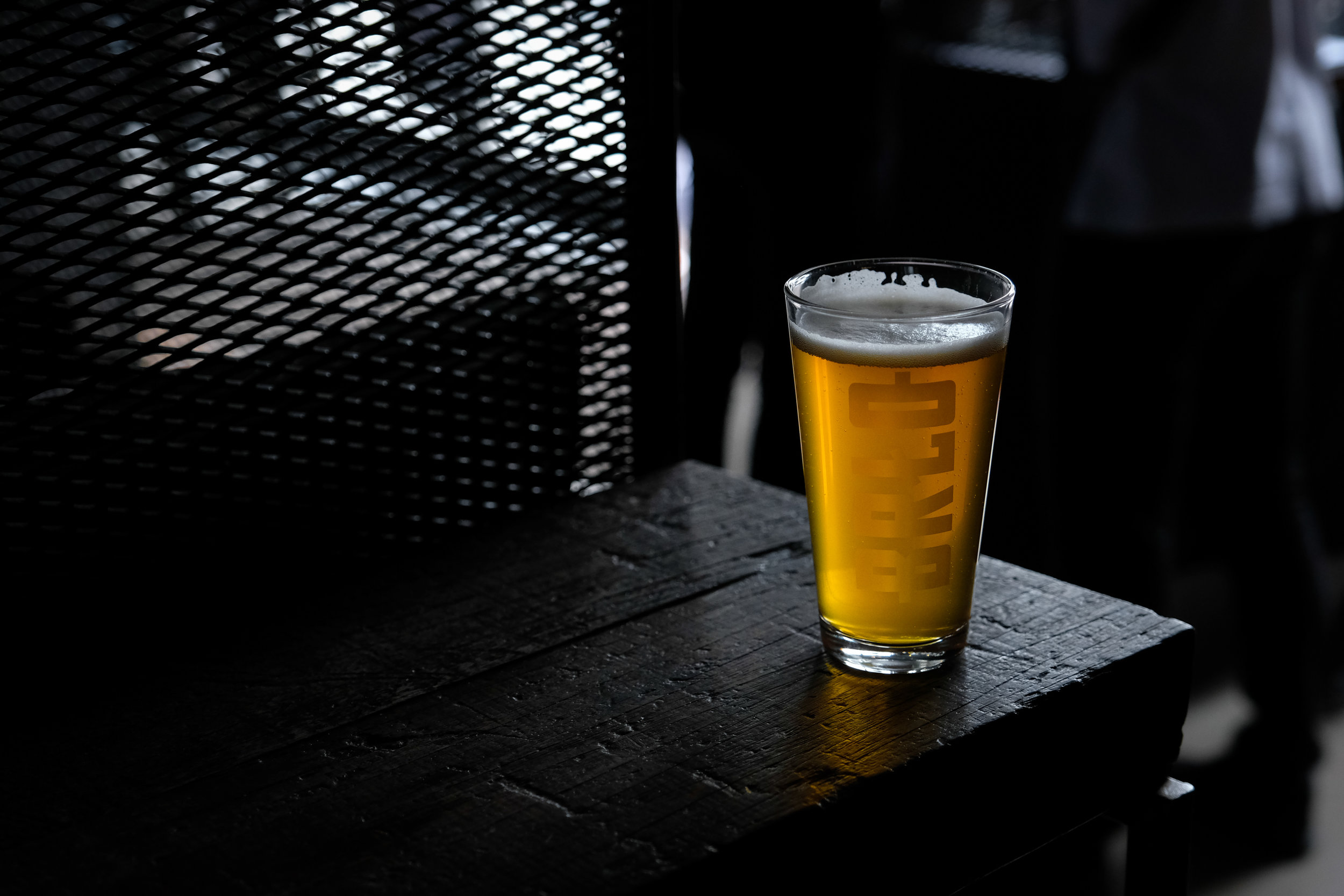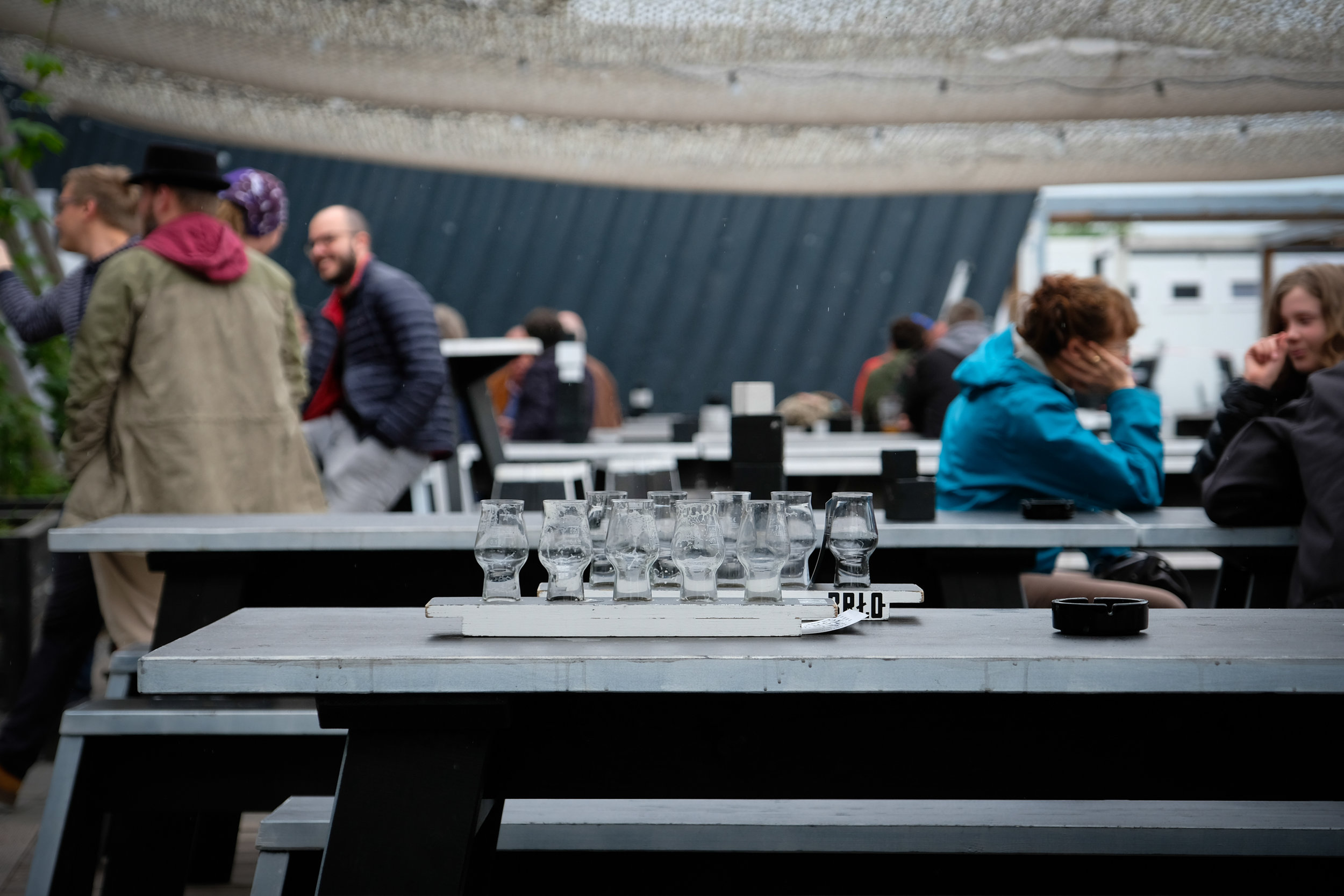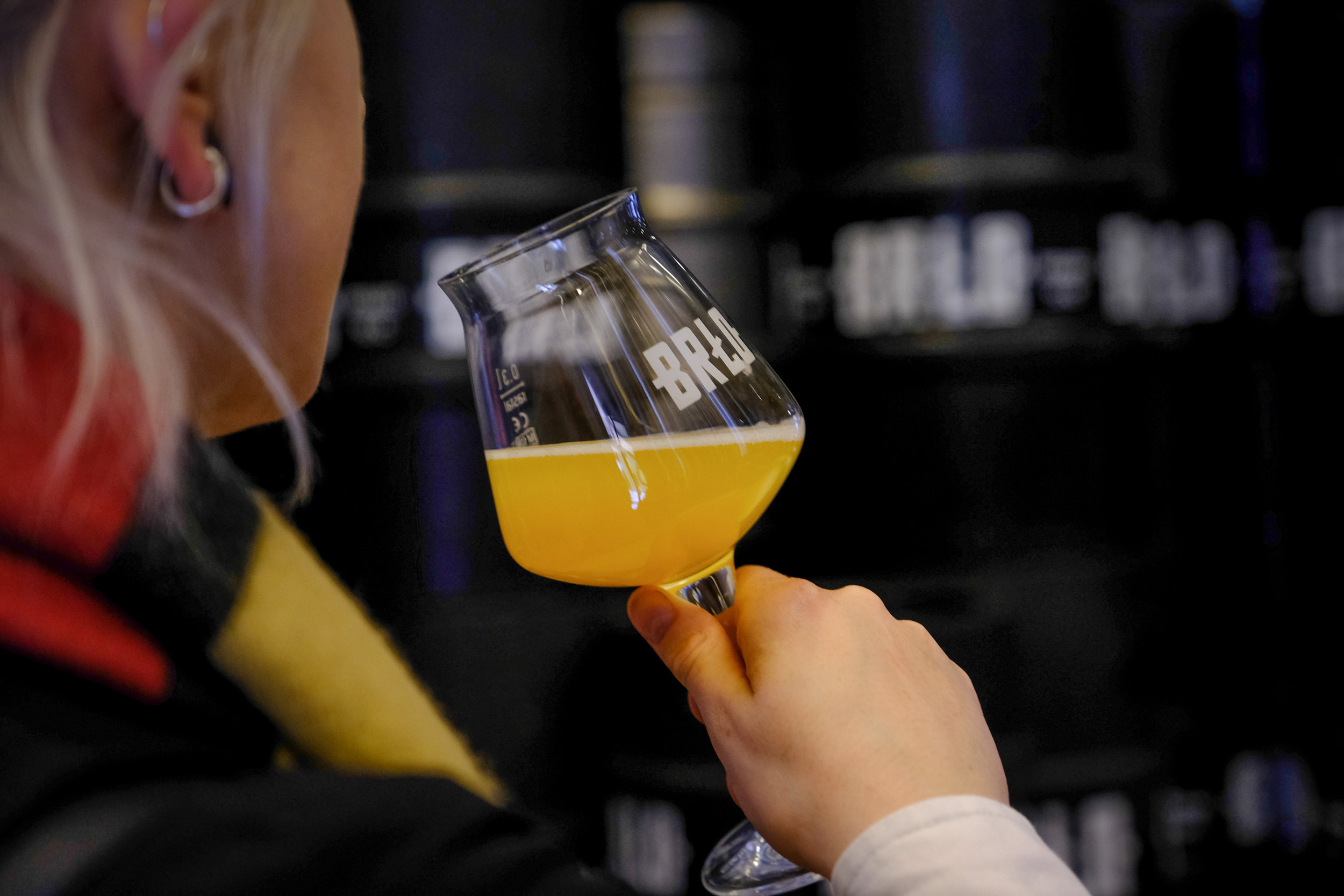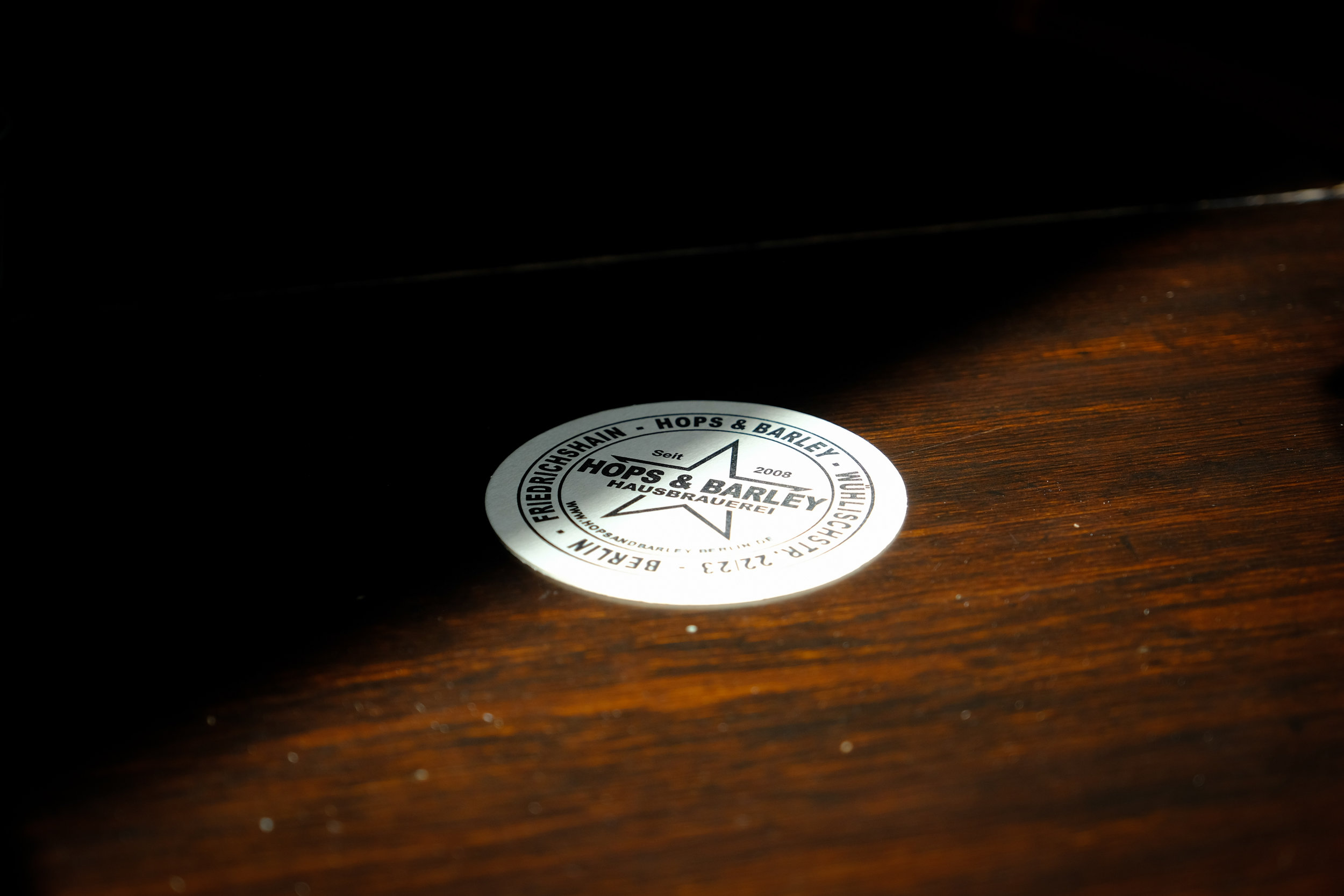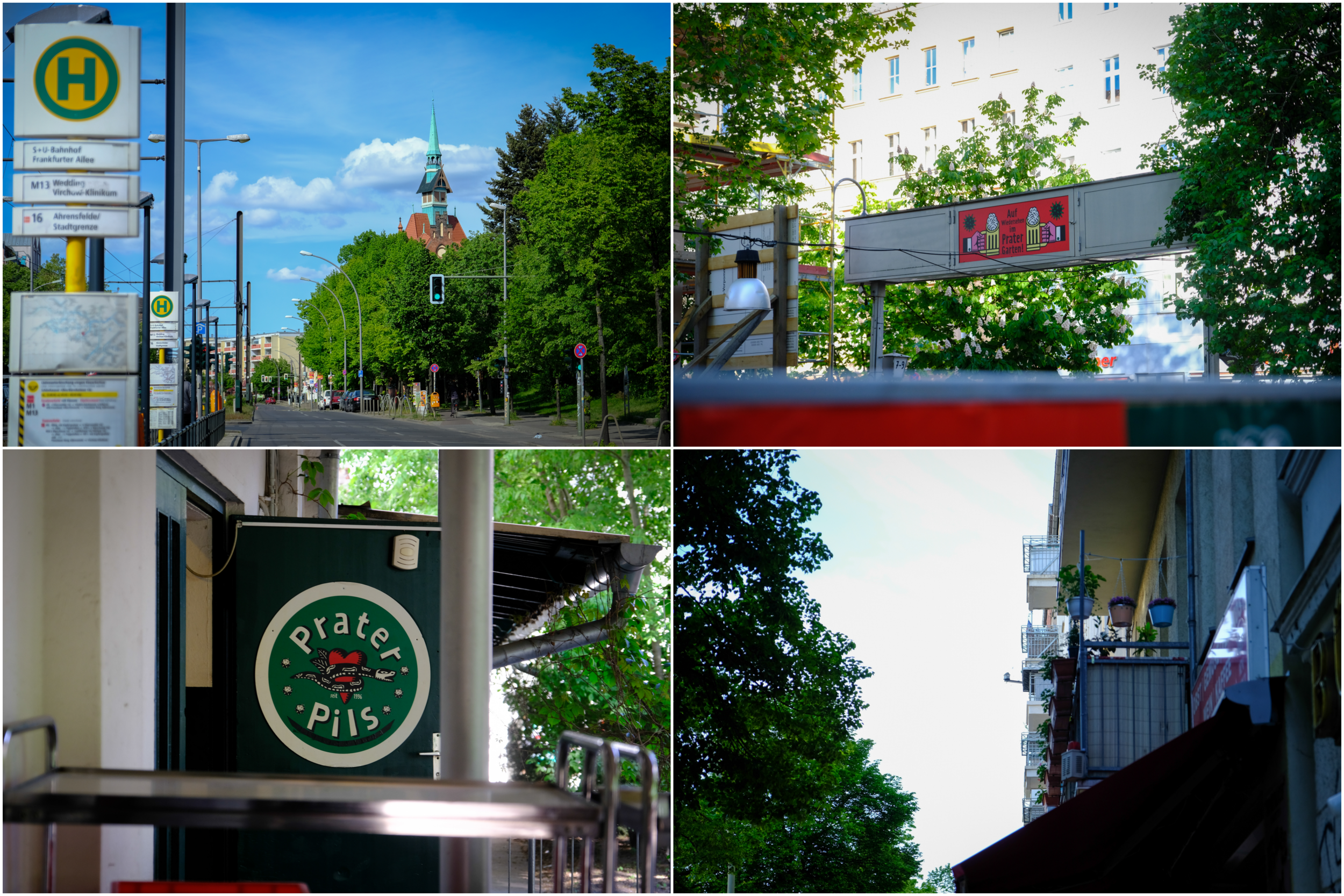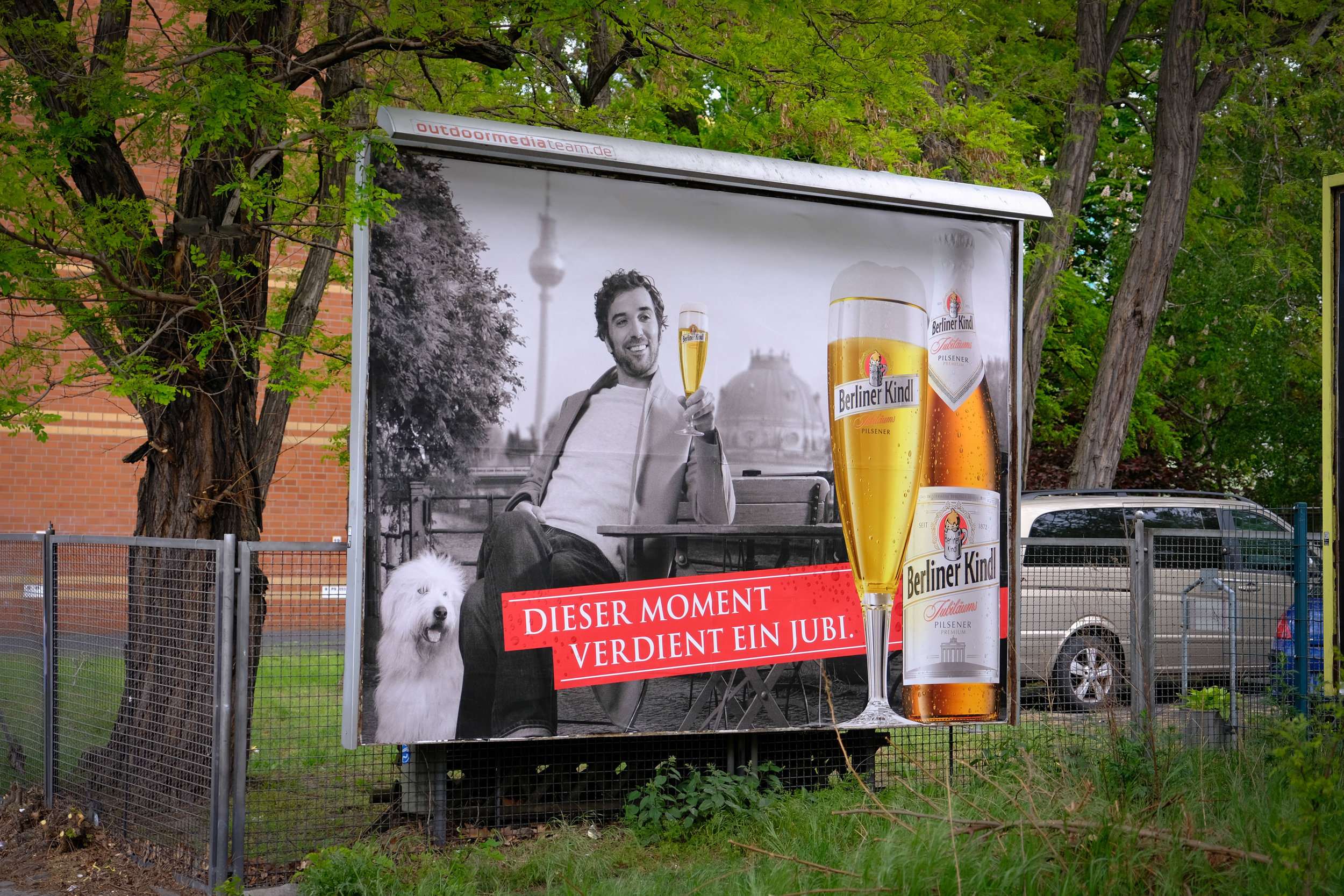Berlin is like an old, unpredictable friend. Last time I was here, I drank gin with a drag queen in a dive bar at 3 a.m. while an inflatable penis rotated overhead. This time around, I’ve found myself holding a glass of Champagne at a brewery owner’s birthday party. If you know just what you’re in for, maybe you’re not doing it right.
The journey from Berlin’s Schönefeld Airport into the city is one I’ve come to love over numerous visits. From the Wes Anderson-esque railway platforms and the dated trains (the U-Bahn goes underground, and S-Bahn supposedly runs at surface level, but, bafflingly, they seem to interchange on a whim) to the blurred vistas of continental-European apartment blocks, Berlin always feels different to other major European cities. And so it should—it’s a city stacked with, and wracked by, history. It feels at odds with the rest of Germany, much of Europe, and, at times, itself.
Wrenched apart in the division of Germany in the years following World War II, Berlin was hewn roughly down the middle for decades. Today, token pieces of the infamous Berlin Wall still stand—some stretches run for hundreds of meters, while some are a few feet wide, as solemn as gravestones, though inscribed with graffiti. That trauma still feels near at hand: the city only reunified a little over a generation ago in 1990, some 45 years after its split.
In the wake of Cold War surveillance, separation, and extreme difficulty, Berlin erupted into unparalleled festivity: week-long parties in abandoned Nazi bunkers and old power stations and raves in mind-bending clubs set the city’s nightlife apart.
Though Berlin’s party scene is perhaps a little tamer than during its heyday, and a little more tourist-driven, certain hangovers from its decadent, drug-fueled past give it an edge. Some bars rarely close, and others stay open until the wee hours. 24-hour convenience stores, known as Spätkaufs, or Spätis, are as common as luminous orange trash cans.
One of the first things I do upon arrival is head into one of these tiny corner shops and buy a fat bottle of Tegernseer Hell, folding myself around beer crates stacked as high as my head. I drink it overlooking the Spree, the river that winds through Berlin’s center and east, towards Poland.
After my partner and I check into our hotel, we head out for a beer, passing sign after sign offering Krombacher, Radeberger, or Berliner Kindl in favor of BRLO Brwhouse, just a short walk away. The brewery, housed in an expanse of shipping containers beside a gravel garden, is perched on the edge of a long, green park, across which a U-Bahn bridge stretches, punctuating the afternoon with flashes of bright yellow as trains run past. The park itself used to be a wasteland, says BRLO co-founder Katharina (Katha) Kurz.
“It belonged to the German railway company, and you couldn’t even access it,” she tells me. “Then in 2011 they opened this park.” Though it started life as a nomadic brewery, BRLO moved in shortly after the park opened.
Even in the drizzle, the brewery is busy. For reasons no one’s quite explained to us, there’s a jazzily dressed brass band pumping out pop songs in the middle of it all, taking shelter under a broad umbrella. At one point, they stand under the balcony where Katha’s birthday party is underway—and where my girlfriend and I are surprised to find ourselves, Champagne in hand—and blast “Happy Birthday” upwards, looking for all the world like a modern-day fanfare.
The site is one of two that BRLO occupies. This shipping-container facility, which it shares with a contemporary vegetarian restaurant, focuses on kegged beer. Its other location, in Spandau to the northwest, produces bottled beer. At some point BRLO will have to up sticks and move beyond its boxy shanty town, when the local authorities reclaim the land for development. “Once we have to move [from] here, and we don’t know how fast we can, we can’t be dependent on this brewery,” Kurz says. Until then, Kurz hopes that the brewery’s annual output will reach 8,500 barrels (10,000 hectoliters) across both sites. “I think for German craft, it’s pretty decent. Craft beer is just so small.”
For a country with such long-standing and ingrained beer culture—you’ll literally find bottle caps trodden into the dirt on any given street—German craft beer is small. Back home in the U.K., German beer is still often seen as homogenous, as an unrelenting swathe of Pilsner; via a range of varyingly authentic Oktoberfest events, German beer presents the excuse to get publicly shitfaced. Even within Germany, home to dozens of native beer styles, beer is often simply, well, beer.
“Still, a lot of people go into a bar and say, ‘A beer, please,'" Kurz says. “They don’t say, ‘What kind of beer do you have?’ or ‘I want this or this.'”
“We always had the perception that we have the best beer in the world. Like, ‘All this foreign crap—who needs that?’ We are very patriotic when it comes to beer. Beer’s very regional, as well, which appeals very well to patriotism.”
Despite these factors—which could give the impression that Germans simply don’t care about beer—there’s a belief that theirs is the best. “You have to look at Germany overall when you look at beer,” Timo Thoenissen, founder of Berlin brewery Strassenbräu, tells me. “We always had the perception that we have the best beer in the world. Like, ‘All this foreign crap—who needs that?’ We are very patriotic when it comes to beer. Beer’s very regional, as well, which appeals very well to patriotism.”
“We are number one; why try harder?” Andreas Martin, husband of Schneeeule Brauerei founder Ulrike Genz, agrees. “Germans tend to drive their €60,000 SUV to the discount supermarket, buy a 20-cent sausage to put on their €5,000 grill; on the way home from the supermarket they buy a crate of beer (10 liters) for €8, and €50 motor oil. That’s Germany. Beer has to be cheap and available, and that’s it. That’s the only thing Germans want from beer.”
As we tear ourselves away from Katha’s unfolding birthday party—with difficulty, as bottles of Cascade and 3 Fonteinen have just been unearthed—and plonk ourselves onto a train with a Wegbier in hand, I’m left wondering if that actually is all Germans want, given how busy BRLO’s beer garden is.
In Friedrichshain, the streets are busy with Sunday morning shuffling. Cafes throng with countless brunch parties, and families stroll through parks while beer gardens begin to fill up. A little of last night’s flotsam and jetsam remains underfoot: empty Lager bottles line the curb like roadkill on a highway.
Hops & Barley, one of the first brewpubs in the city, is quiet inside, though by the time we’ve parked ourselves by the window, the trestle tables out front are dotted with tall pints. As I work my way through a crisp pint of Pilsner, I see a glimpse of the German drinking culture described by Thoenissen and Martin: no one’s on Untappd, or poring over menus; people drink casually, while watching football (FC Union Berlin are in the final of the German league, and it’s gripping—even we’re enthralled) or while deep in conversation. It’s great-quality beer, but it’s convenient. It’s not expensive, either.
One might think that a country with beer at its heart would delight in the blossoming of a new, exciting addition to the industry. In fact, it’s that very reliance on tradition that’s hampering the rise of craft beer. If you have the best beer in the world, and it’s cheap, why would you want anything else? “TV Beer” (Germany’s answer to macro beer, so named because of the regular ads on national television) is objectively of a high standard, so there’s little for a burgeoning, artisanal industry to rail against. Tasteless, unimaginative, and poor-quality beer never dominated the taps of Germany’s bars, pubs, or bierkellers—when we visit Berlin’s oldest beer garden, Prater Garten, we find it brimming with people enjoying Pils and Hefeweizen (and plentiful pretzels) in the sunshine.
“From our perspective, we knew the craft beer movement took off so quickly on the West Coast in Canada and the USA partially because there just hadn’t been a tradition of good beer, however narrow the range of styles,” says Jenia Semenova, co-owner of craft beer venue The Muted Horn. “So when people were finally given the option to drink something tasty, and local or fresh, they really responded well. By contrast, Germany has always made some excellent beer. The range of styles is relatively small, mostly centering around Lager, Pilsner, and Helles, but the quality and value is really great. So it becomes more difficult to convince people to try something completely different and more expensive when they are happy with the options they currently have.”
“Nobody has the guts to go to the EU court. But we would do it. We would be the killers of the Reinheitsgebot.”
Thoenissen’s theory of regionality having a big impact on the state of German beer holds a lot of water. “If you go down to Franconia and other regions in southern Germany, you have much stronger beer culture, so of course it’s much harder there for any other beer styles to get into that market,” he tells me. “There was no one crying for better beer like in other countries, where they’re really drinking garbage. So that’s what took longer overall, and that’s why Berlin is changing faster.”
He does think, however, that Berlin presents the perfect environment for a craft beer industry to develop, due in part to the Radeberger Group (the largest brewery group in Germany), which maintains a local monopoly. “We only have one brewery in Berlin that produces the big Berlin beer—Berliner Kindl, Berliner Pilsner, Berliner Schultheiss—it all comes from one place. So, that’s boring, and that’s what people in Berlin don’t really like. So, definitely, this is the right place for craft beer.”
Strassenbräu, the brewery Thoenissen set up four years ago, was founded on that disinterest in Berlin’s beer identity. Having lived in the U.S. and Australia for a while, Thoenissen returned to Berlin and quickly grew bored with local beer. “I thought, ‘Why the heck—we’re in such a modern, creative city, and the beer culture here is garbage,'" he says. “There were like two or three breweries back then that were doing something ‘crafty,' but even then it wasn’t on any comparable level to elsewhere.”
Thoenissen had some homebrewing knowledge, and soon found an experienced brewmaster, Sebastian Pfister, to help him launch Strassenbräu. Behind the aggressively blue neon sign on its facade, Strassenbräu is tight on real estate: sinks turn into tables, the brew floor doubles as a tasting area, and fermenters are tightly jam-packed into the cold store directly behind the bar. At one point, I literally get stuck between tanks. Production is at capacity, and Thoenissen is also brewing off-site to meet demand, particularly from restaurants.
Strassenbräu’s lineup features markedly international styles, such as Pale Ale, IPA (including New England variants), Barley Wine, and Red Ale. A few beers do allude to the brewery’s German heritage, though with a twist: an orange and pineapple Pilsner, and a ‘Haferweizen IPA,' a White IPA with oats and wheat in the grist.
Along with BRLO, Brewer’s Tribute (which opened in 2015 to fight “against the decreasing variety of tastes and dwindling quality of industrially produced mass beers”), and Schneeeule, Strassenbräu is part of a small contingent of native-run craft breweries in Berlin. According to Martin, they’re the only ones not owned and run by American, British, Australian, or Israeli immigrants. “The reason why Berlin has a) The most craft beer breweries in Germany; and b) Is the only relevant craft beer market in Germany, is because of expats," Martin says.
“Now the question is, ‘Are we doing our own thing here, do we develop German craft beers or Berlin craft beers, or are we just copying what’s happening internationally?’” Thoenissen says. “We have one style, Berliner Weisse, which [Strassenbräu] are also brewing now—that’s where I see a lot of potential, because that’s our style and that’s our history.”
Though Germany’s craft beer scene is much younger than America’s, there are parallels that can be drawn between the two. Both, for instance, suffered during the 20th century, due to the destruction of WWII and Prohibition, respectively. “There was no German beer culture left after the Second World War,” Martin explains. “You have just the Bamberg area where people are still proud of their beer, but the beer culture was basically erased in most parts of Germany by the Second World War. After the war, especially in Berlin, there was nothing left. It was completely destroyed. Then they set up new breweries, but they didn’t set up old Berliner Weisse breweries. A) The knowledge was gone; b) Brewing Pilsner was just faster and cheaper.”
Though Berliner Weisse is a key part of the city’s beer heritage, post-war Berlin nearly lost its 500-year-old, namesake beer.
“There were just six breweries left: four in the West and two in the East,” Martin says. “They all basically closed until the reunification—after this, the Radeberger Group, a subgroup of Dr. Oetker, were running around Berlin and buying everything. They bought every brewery, within like, five minutes. They closed down most of them, and just kept the most successful: Berliner Kindl, Berliner Pilsner, and Schultheiss.”
“And they’ve chosen the easiest way to produce Berliner Weisse, of course the industrial way of Kindl,” says Ulrike Genz, founder and head brewer of Schneeeule (which translates to “Snowy Owl,” and is pronounced shnay-oiler). “It’s an industrial way to produce sour beer—it’s like kettle souring, but I think it’s not real kettle souring. I think they add a lactic-acid solution or something.”
Berliner Kindl’s widely available Berliner Weisse often comes pre-mixed with either raspberry or vivid, green woodruff syrup. “The problem with most Berliner Weisse is that nobody knows it here, really, except for this touristy drink that’s premixed with syrup, like, ‘Red or green?’” says BRLO’s Kurz. “I’ve had fights with people who are like, ‘This is not a Berliner Weisse; it should be red or green.’”
In fact, my first encounter with “traditional” Berliner Weisse a little over three years ago was premixed with syrup, in Bei Schlawinchen, a tiny dive bar that’s supposedly always open, and is decorated with all manner of alarming miscellany. On the rare occasion you can find the beer unsweetened, it’s nothing like the Berliner Weisse commonly brewed by contemporary breweries. For that matter, neither is Schneeeule’s.
Genz, from underneath her trademark straw hat, recalls how the master brewer of Berlin’s VLB, a nearby institute that provides research, training, education, and other services for the brewing industry, was one of the few remaining fans of old-school Berliner Weisse. He poured some he’d brewed in the institute’s basement at a festival, and Genz fell in love. “I drank it the whole night” she says. “I looked for Berliner Weisse in Berlin, and there was nothing, except for Kindl. Kindl was horrible. It is still.”
Genz studied brewing science for 10 years before taking a break to have a child. With her interest in Berliner Weisse firmly piqued, she then spent three or four years, according to Martin, developing the “whole Berliner Weisse thingy” before Schneeeule started trading in 2016. Though much of the knowledge has been lost, through speaking to old brewmasters and hunting down old recipes, Genz and Martin have begun to resurrect Berlin’s beer heritage.
A fitting metaphor for the traditional Berliner Weisse the couple are championing in the face of mass-produced, ahistorical beer is their brewery itself. It’s made up of three small rooms on the edge of an international turbomachinery production plant. Gargantuan fittings and chambers produce deafening clangs that ring out during our conversation. Wort is produced offsite, then Genz ferments, blends, and conditions in this small space. Schneeeule has now reached capacity, and the couple are looking to move—they quickly outgrew this nest, and the last before that: interest and demand in their beer has taken them to London, Russia, and the U.S. recently, and they’ll head back out to America this fall to pour at the Shelton Brothers Festival. Who said real Berliner Weisse was dead?
“The whole Reinheitsgebot is complete bullshit,” loudly proclaims Martin, spectacles glinting in the bright sunshine. The Vorläufiges Biersteuergesetz 1993 (Provisional Beer Law of 1993), colloquially known as the Reinheitsgebot, or “German Purity Law,” is a major prohibitive factor in the German beer industry. The most commonly known version of the law was first instated in 1516 in Bavaria (though others predate it), and originally limited brewers to just three ingredients: water, barley, and hops, as the existence of yeast remained undiscovered at the time. Though arguably archaic, an updated version is still in effect across the country today.
To brew a beer with more than just those base ingredients, a brewer legally has to file for permission, a process that can take almost a year. “It’s a little bit frustrating, in terms of going to the authorities and everything,” adds Kurz. “Obviously we just want to be as creative as possible, so it’s limiting.”
A few breweries, however, completely disregard the law. Some, like BRLO, will overlook it when brewing a one-off beer. Berlin, according to both Kurz and Martin, is significantly more lax in terms of the law’s enforcement than other, stricter, regions, such as uber-traditional Bavaria. Even within Berlin, it’s wholly dependent on district. In Wedding, where Schneeeule resides, the law’s mostly overlooked. In Marzahn to the east, Martin says it’s much more strict. “They get fucked every week,” he says of three breweries in the area.
There are other ways around the law, too. Given that it only governs beer brewed within Germany’s borders, imported beer is exempt—a factor that one or two brewers have cottoned on to. “The insane thing about Reinheitsgebot is that when you brew something out of Reinheitsgebot, like, I don’t know, you dry hop it, you’re not allowed to sell it as a beer in Germany," Martin explains. “Except, say, if you brew it in Poland, you can do whatever you like! Then you can import it as beer.” By brewing a little over 40 miles away, over the Polish border, brewers can effectively sidestep an archaic obstacle that many would happily do away with.
“I was talking to the lawyer that is working for the Brauer-Bund, the Brewers’ Guild of Germany, and the only reason the Reinheitsgebot is still there is because nobody in Germany wants to go up against it in court," Martin says. “You have to go to the EU court because it’s damaging your own economy: brewers in Germany are not allowed to do what brewers in Poland are. Nobody has the guts to go to the EU court. But we would do it. We would be the killers of the Reinheitsgebot.”
Martin’s frustration with the law is justified. Smaller brewers with fewer resources are hindered by it in ways that those with the wherewithal to brew across the border aren’t. The law itself is a zip-code lottery, dictated by the temperament of local government employees. In comparison to other brewing industries in Europe and America, it’s not even a question of level playing field: German brewers are playing in an entirely different park.
Berlin in the rain is calm. Spring showers chase people into bars, thinning footfall. The smell of damp concrete dominates. We duck out of the drizzle into The Muted Horn in Neukölln to watch the world splash by. Though it’s only my first visit, I quickly realize why this bar seems so familiar: as in most beer venues in Berlin, the majority of drinkers are speaking English. Accents are a mix of American, British, and miscellaneous, Americanized Euro-twang.
I’m struck by how many beers are imported: the U.K. and U.S. dominate the tap list, with a hint of European beer thrown in, seemingly for good measure. Even the stickers slapped on the metal planters in front speak to an imbalance.
“There are definitely beers that Germans make better than anyone else, at a better value. We get some of these amazing Franconian Lagers for such a great price, that even if someone in the U.K. or U.S. or Canada could brew a beer exactly as good, it would certainly cost more after transportation,” co-owner Jenia Semenova says. “We try to approach our selection mostly from the perspective of people who live in Berlin now, so we often end up choosing a foreign beer over the German one available down the street, because that’s the unique value proposition we can provide to our customers.” Because of the low price point and ease of accessibility of most German beers, craft beer bars end up importing the majority of their wares.
“I can’t speak for others in the city, but for us quality of product and the condition of that product is the thing we care most about,” Semenova continues. “Germany currently lacks quality beer infrastructure, cold chain/cold storage is basically nonexistent, and freshness of beer is always a battle as well. That also contributes to why we source beer from the outside, and try to do as much of it ourselves as possible.”
Across the city from The Muted Horn at Protokoll, drinkers spill out through scaffolding onto the sidewalk. Inside, busy bartenders pour a mixed-nationality crowd a range of mixed-nationality beers. In Monterey Bar, a purple-walled and dimly lit rock bar in Prenzlauer Berg, you’ll often find rare bottles from sought-after American breweries, as well as contemporary British beer on draft (a few local breweries, such as Berliner Berg Brauerei and Privatbrauerei Am Rollberg, feature too).
With its vibrant, messy nightlife, strong creative industry, and (formerly) cheap rent—and the pseudo-bohemian lifestyle it subsequently promises—Berlin has become a haven for expats. Those who grow tired of London, Paris, or New York, or who search for a more utopian ideal straight out of art school, have been flocking to Berlin for years, pushing up rent prices, accelerating gentrification of certain areas, and creating the perfect environment for a growing craft beer scene. As Martin points out, expats have been successful—all bar one notable example.
In early April, prior to my visit, American brewing giant Stone Brewing Co. announced it was closing its Berlin brewery, and was selling it to Scottish multinational BrewDog. The brewery, housed in a state-of-the-art contemporary space a little outside of Berlin proper, was billed as a bold move into an emerging market, and was designed to serve as a distribution and brewing center for Stone’s European markets. Its cathedral-like building, filled as it was with trees and lampposts, was truly a sight to behold. In the end, however, it closed after just three years in the city.
In his blog post announcing the site’s closure, Stone founder Greg Koch seemed to lay the blame at the feet of the German people for overlooking good beer in favor of “the cheap stuff." Thoenissen, however, has other views.
“The biggest mistake they made was they haven’t prepared their market: you can’t just build a brewery and then expect to sell all of the beer you produce, everywhere, without checking if people even want it,” he says. “One of the other mistakes was that they tried to sell beer wherever they could: they were selling their cans to all of the grocery stores and retailers they could possibly sell to. If I can get a Stone IPA can for €1, why should I pay €5 in a craft beer bar?”
He also points a finger at Stone’s “authoritarian” structure, and how they waded into an unknown market without knowing how it worked. “Everything comes from Greg in the United States. He has no idea about the Berlin market, he has no idea what the people want or how things worked.” If you’re going to set up shop in a country other than your own, it seems, you have to get to know it first.
Tom Crozier, co-founder of Vagabund Brauerei, a short drive from Schneeeule in Wedding, moved to Berlin 10 years ago from Maryland. Having never left the U.S. before turning 25, he wanted to see more of the world. With a friend, Matt Walthall, living in Berlin, he flew out to the German capital. If he didn’t like it, Crozier figured, he could easily travel somewhere else, or simply head home. He’s been here ever since.
“We drank a lot of beer together and I was looking for other craft you could find," he tells me over a pint at his brewpub. “I couldn't really find much and started homebrewing as an extension of just trying to find the beers we wanted to drink; classic story.” While it is a classic story in older craft beer markets, Crozier’s quick to explain why it’s not so typical in Berlin. “That cliché is not a cliché here. It's something unique, and we felt very blessed that we’ve been able to have that building plan," he enthuses.
After cutting their teeth homebrewing, Crozier and Walthall, along with their friend David Spengler, opened Vagabund in 2013. Though young by American standards, Vagabund is now considered a veteran of the Berlin scene; its founders’ nationality hasn’t seemed to stymie its popularity. The crowdfunding campaign that helped them open the brewery was “overwhelmingly German-supported," says Crozier. “90% of the money we got from that was from within Germany. So that was a very encouraging sign to start with.”
In the six years it’s been open, Vagabund has cemented itself as part of Berlin’s beer furniture. Based in a humble, one-room pub on a quiet, residential street, the brewery’s small team brew simple-but-delicious beers for a regular crowd, made up of both locals and visitors.
“For us, and some of the other small breweries, the idea of just locally produced, fresh beer is what we actually are doing our trade with most of the time,” says Crozier. When I ask if he believes the assertion that Berlin’s craft beer scene stands on the shoulders of foreigners, and the beer cultures they bring with them, he’s quick to dismiss the idea. “I'd say that's not fair at all to all the Germans who are out there enjoying craft beer too—and there are plenty of them.” He gestures to the two Germans sat at the bar, who have comfortably occupied their stools since it opened. “Sometimes it is an all-German room; sometimes you do find that it is lots of people who have come to Germany for tourism or to live abroad.” He shrugs: “It really just depends.”
“We try to approach our selection mostly from the perspective of people who live in Berlin now, so we often end up choosing a foreign beer over the German one available down the street, because that’s the unique value proposition we can provide to our customers.”
Though both Martin and Thoenissen look to the resurrection of Berliner Weisse as a way for the city to regain a sense of tradition, Crozier sees Berlin as a tabula rasa. “[Berlin has] been bastardized for decades and it's pretty sad. It's a good playground for creativity all round, too. Within beer, it doesn't have a solid identity so it's enabling craft beer to take a bit of a stronghold.”
Berlin’s craft beer scene may have its work cut out for it when it comes to converting native drinkers, but much of the path-forging has already been done. “It's changing for the best, but it's interesting to see, because I think it is very much like a hyper, sped-up version of what's happened elsewhere in some ways. I think, already, after some years in business, you see some breweries coming and going. Maybe there is a bit of a bubble, and that will probably collapse a bit,” Cozier says.
But he remains hopeful. “It will continue to expand, but I hope that it expands a lot. There's a piece of craft beer pie out there for people who want a craft beer. We're not trying to change German tradition. We just want to add our tradition to that mix.”
Despite the challenges—from the authorities, from monolithic TV beer, and from Berlin’s stalwart traditionalists themselves—the city’s craft beer scene is unquestionably on the rise.
“I think that you can feel that it’s still at the beginning,'' says Kurz. “That has a magic in it. You still know everybody. You feel you can have a big impact in bringing it forward, and I like that.”






